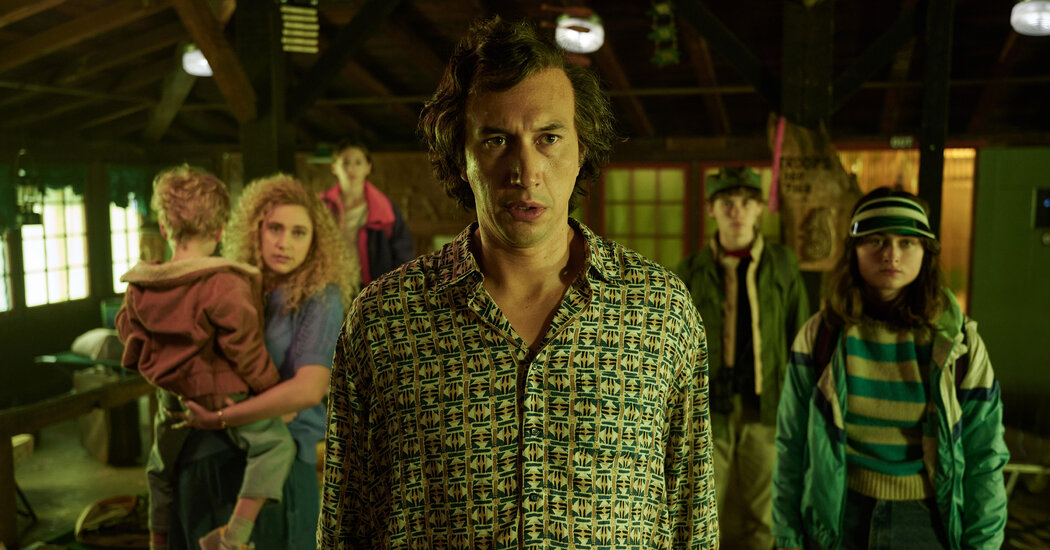
Late in “White Noise,” after the ecological disaster known as the “airborne toxic event,” on the heels of a professional triumph, and in the throes of marital woe, Jack and Babette engage in a discussion of religion with an acerbic German nun. Instead of piety, she offers a pragmatic, borderline cynical view of how faith operates. If she and her colleagues “did not pretend to believe these things,” she says — referring to “old beliefs” in stuff like heaven and hell — “the world would collapse.”
The nun, played by the formidable Barbara Sukowa, has been carefully airlifted from the pages of Don DeLillo’s 1985 novel into Noah Baumbach’s new film. So have Jack Gladney (Adam Driver) and his wife, Babette (Greta Gerwig), who head up a rambunctious blended family in a Midwestern college town. Jack, known in academia by the decorative initials J.A.K., is the founder of the college’s department of Hitler Studies. Babette teaches life skills to the elderly and infirm.
Back to Sister Hermann Marie: “It is our task in the world to believe things no one else in the world takes seriously,” she says. This may or may not be true of nuns, but it can often feel glumly applicable to writers and filmmakers, especially those who try to chart an independent course. Somebody has to care about art and literature. With respect to DeLillo, Baumbach is very much a believer. His “White Noise” is a credible adaptation and a notably faithful one — what an earlier Baumbach character might call the filet of DeLillo’s bristling, gristly book. Very little has been added, and what’s been taken out will be missed only by fanatics. (A warning and maybe a spoiler for DeLillo-heads: The most photographed barn in America is nowhere to be seen.)
The challenges inherent in the project are bravely faced and honorably met. The novel straddles domestic realism and speculative satire. It’s a campus comedy stapled to a family drama and tied up with a ribbon of allegory. Its contemporary topics — no less relevant now than in the ’80s — include intellectual fashion, pharmacological folly, environmental destruction and rampant consumerism. These collide with eternal themes: envy, love, the fear of death.
Baumbach’s reverence for the material is evident from the trompe l’oeilopening sequence — footage of car crashes from old movies, accompanying a lecture by a professor of popular culture — through the end credits, which turn DeLillo’s vision of supermarket heaven into a bouncy LCD Soundsystem music video. Driver, paunchy and swaybacked, is the very model of a modern middle-aged professor, his intellectual curiosity muffled by a certain complacency. He’s a happy man whose vocation is horror.
In the campus lunchroom, he sits in on bull sessions with colleagues, inhaling gusts of competitive explanation. The movie’s dialogue, compulsively true to DeLillo, bristles with explanations and random facts. Except for the toddler, the kids in the Gladney household — Jack’s son, Heinrich (Sam Nivola), and his daughter, Steffie (May Nivola); Babette’s daughter, Denise (Raffey Cassidy) — bounce around the kitchen like human Google results pages, asking out-of-left-field questions and citing semi-relevant data. Jack and his pal Murray (Don Cheadle), the car-crash scholar looking to expand his academic portfolio, are more inclined to hermeneutics. In one of Baumbach’s bravura set pieces, they improvise a classroom duet for an audience of rapt undergraduates, comparing and contrasting mother-love and the death drive in Hitler and Elvis.
What they have to say sounds pretty dubious — Murray and Jack broadcast the kind of mock-profundity more common among students than faculty — and the question is to what extent that’s deliberate. “White Noise” is a frequently funny movie that is also utterly in earnest.
The kids do say the darnedest things, but they are also vessels of anxiety and avatars of vulnerability. The wounds and salves of family life, in particular the abrasions of matrimony, are Baumbach’s specialty. Jack and Babette’s particular marriage story, which comes into focus in the final third of the movie and is tied up with a noirish pharmaceutical subplot, is the heart of “White Noise” — rawer and sweeter than the surrounding material. Driver and Gerwig give warmth and texture to characters who were, in DeLillo’s pages, a little abstract. Their function was largely to organize the novel’s ideas.
The status of those ideas is the biggest problem with Baumbach’s film. He is perhaps too dutiful in transcribing DeLillo’s vision of contemporary life, a landscape of material comfort and intellectual dread, dominated by brand names, untrustworthy information and the looming threat of destruction.
Random insights, like Murray’s observation that the family is the origin of misinformation, are preserved as if they were museum pieces in a carefully curated historical exhibit. Making “White Noise” a period film — the uncannily precise ’80s environment is the work of Jess Gonchor, the production designer, and Ann Roth, who did the costumes — inevitably blunts its impact. Things that might have made readers squirm in the 1980s are shrouded in nostalgia in 2022. It’s hard to feel existential terror when you’re ogling the A.&P. supermarket, the landline phones, the printed classified ads and the boat-shaped rear-wheel-drive station wagons.
Within this world, you can see premonitions of our own, most notably in an evacuation shelter where anxious people create in effect an IRL prototype of Twitter, gathering around unverified experts (including Jack’s son, Heinrich) and parroting their wisdom. Baumbach, working on a larger scale than he has before, pulls off a few fine cinematic coups, one of them involving that station wagon fording a swollen stream.
But there is something detached about the film, a succession of moods and notions that are often quite interesting but that never entirely cohere. “White Noise” is an expression of sincere and admirable faith. I just wish I could believe in it.
White Noise
Rated R. The fear of death. Running time: 2 hours 16 minutes. In theaters.